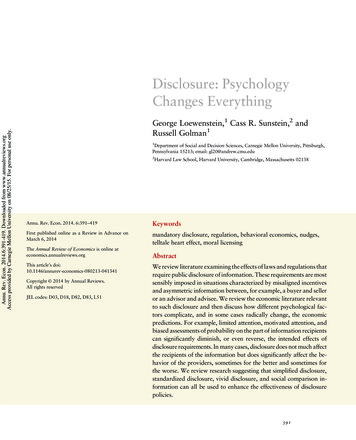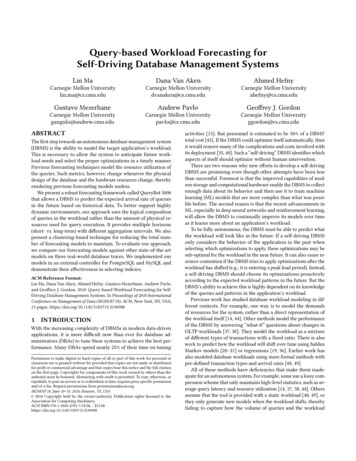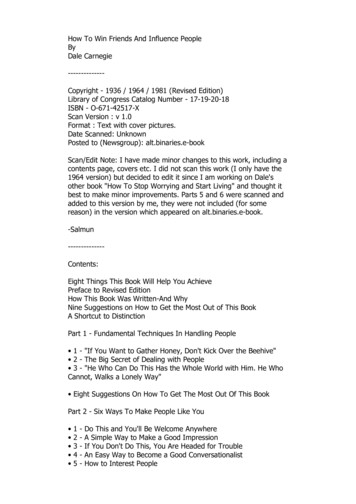
Transcription
ANNUALREVIEWSFurtherAnnu. Rev. Econ. 2014.6:391-419. Downloaded from www.annualreviews.orgAccess provided by Carnegie Mellon University on 08/25/15. For personal use only.Click here for quick links toAnnual Reviews content online,including: Other articles in this volume Top cited articles Top downloaded articles Our comprehensive searchDisclosure: PsychologyChanges EverythingGeorge Loewenstein,1 Cass R. Sunstein,2 andRussell Golman11Department of Social and Decision Sciences, Carnegie Mellon University, Pittsburgh,Pennsylvania 15213; email: gl20@andrew.cmu.edu2Harvard Law School, Harvard University, Cambridge, Massachusetts 02138Annu. Rev. Econ. 2014. 6:391–419KeywordsFirst published online as a Review in Advance onMarch 6, 2014mandatory disclosure, regulation, behavioral economics, nudges,telltale heart effect, moral licensingThe Annual Review of Economics is online ateconomics.annualreviews.orgThis article’s ht 2014 by Annual Reviews.All rights reservedJEL codes: D03, D18, D82, D83, L51AbstractWe review literature examining the effects of laws and regulations thatrequire public disclosure of information. These requirements are mostsensibly imposed in situations characterized by misaligned incentivesand asymmetric information between, for example, a buyer and selleror an advisor and advisee. We review the economic literature relevantto such disclosure and then discuss how different psychological factors complicate, and in some cases radically change, the economicpredictions. For example, limited attention, motivated attention, andbiased assessments of probability on the part of information recipientscan significantly diminish, or even reverse, the intended effects ofdisclosure requirements. In many cases, disclosure does not much affectthe recipients of the information but does significantly affect the behavior of the providers, sometimes for the better and sometimes forthe worse. We review research suggesting that simplified disclosure,standardized disclosure, vivid disclosure, and social comparison information can all be used to enhance the effectiveness of disclosurepolicies.391
1. INTRODUCTIONAnnu. Rev. Econ. 2014.6:391-419. Downloaded from www.annualreviews.orgAccess provided by Carnegie Mellon University on 08/25/15. For personal use only.Mandatory disclosure of information, targeted transparency (Weil et al. 2013), is among themost ubiquitous and least controversial elements of public policy, often promoted as an attractive alternative to so-called hard forms of regulation. Who can oppose low-cost policiesdesigned to provide health and safety warnings to workers, energy-efficiency information toconsumers, privacy information to those giving personal data to companies over the Internet,or disclosure of the financial risks associated with investments, home mortgages, credit cards,and auto loans? Despite a paucity of data supporting the efficacy of such policies, informationdisclosure has been broadly advocated as an appropriate response to a wide range of social andeconomic problems (e.g., Bebchuk & Jackson 2013, Guttentag 2004, Kleindorfer & Orts 1998,Lansky 2002, Sage 1999).An important advantage of disclosure requirements, as opposed to harder forms of regulation, istheir flexibility and respect for the operation of free markets. Regulatory mandates are bluntswords; they tend to neglect heterogeneity and may have serious unintended adverse effects. Forexample, energy-efficiency requirements for appliances may produce goods that work less well orthat have characteristics that consumers do not want (Allcott & Greenstone 2012). Informationprovision, by contrast, respects freedom of choice. If restaurant patrons are informed of the caloriesin their meals, those who want to lose weight can make use of the information, leaving those who areunconcerned about calories unaffected. If automobile manufacturers are required to measure andpublicize the safety characteristics of cars, potential car purchasers can trade safety concerns againstother attributes, such as price and styling. Disclosure does not interfere with, and should evenpromote, the autonomy (and quality) of individual decision making. If properly designed, it shouldalso increase efficiency, helping to avoid cases of market failure resulting from incomplete andasymmetric information coupled with misaligned incentives (e.g., Akerlof 1970, Ross 1973).Standard economic theory offers several explanations for why the provision of information occurring naturally, as a function of market forces, may be suboptimal. Information about consumerproducts is typically provided by sellers, who advertise their products to attract consumers. Sellers ineffect subsidize the provision of information that complements their products. However, when sellerspossess information indicating the low quality of their products, they may not voluntarily choose torelease this information. This information is still valuable to consumers, and in some cases, there isan active market for product quality information (e.g., provided by Consumer Reports magazine).Often, however, this information can be viewed as a quasi-public good that, because of the free-riderproblem, may be underprovided relative to the social optimum. The problem is that one consumermay pay for valuable information that he or she uses to avoid purchasing a low-quality product, butother consumers can then gain this information by observing his or her decision not to purchase theproduct. The market for information fails. For this reason, much, and perhaps most, of the information provided in mandatory disclosures (e.g., product risk warnings, financial disclosures, ornutrition fact labels) would not be provided by free markets.The cost of providing such information (including the cost of enforcing disclosure regulations) is of course a legitimate consideration (Jovanovic 1982). Mandatory disclosure canbe justified by an efficiency argument when the societal gains from information provisionoutweigh the societal costs (Coffee 1984). A comprehensive accounting of costs, moreover,should include the time that people need to process the information; the opportunity costs ofdistracting attention from existing information; and even, in some cases, the emotional costs ofdealing with the information. Graphic cigarette warning labels, for example, might seem to below cost, but they may well reduce the utility of people who continue to smoke (Loewenstein &O’Donoghue 2006), and at least in principle, that loss should be taken into account. The same392Loewenstein Sunstein Golman
Annu. Rev. Econ. 2014.6:391-419. Downloaded from www.annualreviews.orgAccess provided by Carnegie Mellon University on 08/25/15. For personal use only.is true of requirements to disclose the caloric content of food, which will have negative hedonicconsequences for those who continue to eat high-calorie foods.Given the potential benefits and the often low cost of information disclosure, it should come as nosurprise that disclosure policies have proved highly attractive to legislators and regulators (Sunstein1999). The Credit Card Accountability Responsibility and Disclosure (CARD) Act of 2009, theAffordable Care Act, and the Dodd-Frank Wall Street Reform and Consumer Protection Act are allpacked with disclosure requirements (on the CARD Act in particular, see Agarwal et al. 2013). Thesame is true of the Sarbanes-Oxley Act (implemented in the aftermath of highly publicized accountingirregularities following the failure of companies such as Enron and WorldCom), as Ripken (2006)notes in an insightful article. In several of its sections, the act does not ban or require specificcorporate or auditor practices but instead mandates disclosure. For example, it does not requirecorporations to include financial experts on their boards of directors but requires firms to disclosewhether they have, and, if not, to explain why not. Similarly, it does not require corporations toadopt a code of ethics for senior financial officers but, if no ethics code is adopted, requirescorporations to disclose why they failed to do so.The ubiquity of disclosure is documented forcefully and amusingly in a paper by Ben-Shahar &Schneider (2010) titled, provocatively, “The Failure of Mandated Disclosure.” The authors devote 12pages to listing some of the numerous and sometimes absurd disclosure requirements embedded infederal and state statutes, administrative regulations, and court rulings, and applying to virtually alltypes of loans, bank accounts, mutual funds, credit cards, securities brokers, credit-reporting agencies,investment advisors, ATMs, pawnshops, payday loans, rent-to-own contracts, installment sales, alltypes of insurance contracts, vehicle rentals, self-storage facilities, car towing companies, car repairshops, and much more. Perhaps the most amusing (if somewhat macabre) example is the requirementthat funeral operators in California disclose to casket purchasers that “there is no scientific or otherevidence that any casket with a sealing device will preserve human remains.”1Perusal of this list suggests a common pattern in situations in which mandatory disclosurerequirements are imposed. In general, such requirements are applied when less informed consumers interact with better informed sellers and when the incentives of the consumers and sellersare at least arguably misaligned. These features characterize situations such as the following:n Interactions between an automobile seller and a potential customer. The seller has betterinformation about the safety of the cars he or she sells, but the customer may havea greater interest in driving a safe car.n Interactions between a chain restaurant and its patrons. The restaurant has betterinformation about the nutritional properties of the food it sells, but the customer mayhave a greater interest in eating nutritious food.n Interactions between a physician and a patient. The physician has better information about theappropriateness of different tests and treatments but may also have incentives to recommendspecific tests, drugs, or services (e.g., surgery) that may not be in the patient’s best interest.n Interactions between manufacturers who outsource production to establishments thatmistreat workers or engage in environmentally destructive patterns of behavior and1Similarly skeptical, Davidoff & Hill (2013) argue that disclosure requirements have limited impact, based largely on thefailure of the extensive disclosures that were in place prior to 2008 to deter even sophisticated institutional investors fromengaging in the risky transactions that led to the 2008 financial crisis. Guttentag et al. (2008, p. 241), in contrast, dismissanalyses of this type on the grounds that “case studies are of limited effectiveness in revealing systemic patterns or indisentangling cause and effect” and present findings from a stylized experiment that, they claim, provides evidence thatdisclosures can deter corporate fraud.www.annualreviews.org Disclosure: Psychology Changes Everything393
consumers. Firms have better information about their production practices, but consumers, although they undoubtedly appreciate low prices, may have a desire to consumeso-called green or socially conscientious products.Annu. Rev. Econ. 2014.6:391-419. Downloaded from www.annualreviews.orgAccess provided by Carnegie Mellon University on 08/25/15. For personal use only.In what follows, we focus on these types of situations, characterized by misaligned incentives andasymmetric information, often referring to the consumers and sellers as the demand side andsupply side of the interaction, respectively.In addition to situations in which disclosure addresses standard economic market failurescreated by asymmetric information and misaligned incentives, we examine situations inwhich disclosure serves the purpose of helping to protect consumers against their own propensity to err. Psychology and behavioral economics provide a new rationale for regulationthat supplements traditional economic accounts (Camerer et al. 2003, Sunstein & Thaler2003). The new rationale involves what might be called behavioral market failures (Sunstein2014). Among other things, behavioral economics enlarges the potential scope of justifiableregulation by introducing the concept of internalities, analogous to the concept of externalities in standard economics but taking the form of costs that individuals impose onthemselves and fail to internalize at the time of decision (Gruber & Koszegi 2001, Herrnsteinet al. 1993).We note that cognitive or motivational errors and internalities alone do not provide a rationale for mandatory disclosure regulations; at least some kind of misalignment of incentives isimportant in such cases as well. Suppose that at time 1, a consumer is making a decision that willharm himself or herself at time 2, with the long-run cost exceeding the short-term benefit. If theseller’s incentives are aligned with the consumer’s long-term interests, the seller will provideinformation or products intended to reduce or eliminate the internality. For obvious reasons,this is rarely the case. If fast-food customers fail to take account of the health consequences ofexcessive calories, for example, then fast-food restaurants can exploit this failure by offeringenticing but unhealthy menu options that are cheap to produce. Likewise, if car purchasers payinsufficient attention to fuel costs, then car manufacturers can offer gas guzzlers that are cheaperto produce and more attractive with respect to the attributes to which consumers attend. Andif credit card users are unrealistically optimistic or prone to procrastination and inattention,financial institutions can offer cards with generally favorable terms but also with high late andoveruse fees.Information disclosure can take a variety of forms (see, e.g., Teisl & Roe 1998, Worsfold &Worsfold 2007). The most appropriate form depends on the situation in which a marketfailure arises. It is important to distinguish between situations in which information is verifiable (and misinformation can be punished) and those in which information is unverifiable.The calorie claims of a fast-food restaurant and the fuel economy claims of an automobilemanufacturer, for example, can be scientifically validated. But if a doctor expresses the viewthat a patient is ideally suited for a clinical trial, there is no realistic way to verify that he orshe really believes that, or is conveying it because he or she will benefit by receiving areferral fee.When information is verifiable, disclosure can focus on rectifying an information asymmetry—on providing information to the less informed buyer or advice recipient to level the informationalplaying field. When a drug company is required to include a warning label with a prescription drug,for example, the warning is designed to mitigate the asymmetry in information between themanufacturer of the drug, who has access to potential side effects, and the patient, who, in theabsence of the disclosure, would not. The same is true when an automobile company is required toinclude a label with the fuel economy of cars (Sunstein 2013).394Loewenstein Sunstein Golman
Annu. Rev. Econ. 2014.6:391-419. Downloaded from www.annualreviews.orgAccess provided by Carnegie Mellon University on 08/25/15. For personal use only.When information is unverifiable, however, mandatory disclosure attacking the informationasymmetry would be useless because there would be no way to know if the disclosed information isaccurate.2 In this case (as well as in the case of verifiable information), the informed party could stillbe required to disclose the misalignment of incentives. In New York State, for example, prospectivehome buyers and sellers are required to sign (to verify that they have been shown) a disclosure formdesigned to inform “potential buyers or sellers with whom [real estate licensees work] of theiragency relationship and the rights and obligations it creates. This disclosure will help you to makeinformed choices about your relationship with the real estate broker and its sales agents.”One might think it should be obvious to disclosees when interests are misaligned, makingdisclosure unnecessary, but existing research suggests that many recipients of advice are not awareof misalignments, or at least behave as if they are not, taking advice from conflicted sources at facevalue (e.g., Malmendier & Shanthikumar 2007). Beyond suggesting to information recipients thatthey should perhaps mistrust information coming from advisors with misaligned incentives,awareness of the misalignment could also encourage advisees to seek out advisors with competinginterests to hear both sides of an argument (Krishna & Morgan 2001). However, disclosure of themisaligned incentives could actually be harmful, too. People might overreact to disclosure, whichmight prevent an individual from getting good advice [see also Li & Madarász (2008), who findthat this can occur even without overreaction], as would be the case if, for example, a sick patientavoided the doctor altogether upon learning of his or her conflict of interest. And when advisors areethically motivated to provide unbiased advice, disclosure of misaligned incentives can potentiallyundermine this motivation (a moral licensing effect that is discussed in more detail in Section 3).Disclosures can also be delivered in various ways. For example, disclosure of a potentialconflict of interest could come directly from a physician during the doctor-patient interaction orcould be provided in a less personal fashion (e.g., via printed information given to the patient bythe receptionist in the waiting room). Disclosure can also be accompanied by greater or lesserefforts to ensure that consumers actually pay attention to it. For example, chain restaurants mightbe required merely to make nutritional information available to those who request it or, as theAffordable Care Act mandates, to post the information on menu boards. From an economicperspective, some of these details might appear inconsequential, but in reality, as we show below,they can matter profoundly.All three of the authors of this review are strong proponents of information disclosure andtransparency. Indeed, Sunstein worked to promote information disclosure in his capacity asAdministrator of the White House Office of Information and Regulatory Affairs in the first term ofthe Obama administration (and also called for increased disclosure as a member of the President’sReview Group on Intelligence and Communications Technologies). Loewenstein coauthoreda dissent on a National Academy of Science report in which he and his codissenters advocatedbroader disclosures of conflicts of interest than those proposed in the report itself (Bero et al. 2009).Nonetheless, we believe that important and reasonable questions have been raised about theefficacy of disclosure requirements. In this review, we provide a, hopefully fresh, perspective on thecosts and benefits of mandatory disclosure, with an emphasis on psychological insights, and we usethose insights to explore when disclosure is least and most likely to achieve its intended purposes,as well as how disclosure can be changed to enhance its efficacy.In Section 2, we provide a brief review of the standard (but surprisingly undeveloped) economicperspective on information disclosure. We show that the implications of economic theory for2Even when information cannot be verified, some honest communication can occur (see Crawford & Sobel 1982, Farrell &Rabin 1996).www.annualreviews.org Disclosure: Psychology Changes Everything395
Annu. Rev. Econ. 2014.6:391-419. Downloaded from www.annualreviews.orgAccess provided by Carnegie Mellon University on 08/25/15. For personal use only.mandatory disclosure are highly dependent on special assumptions and that some of thoseimplications are surprising.In Section 3, we discuss several psychological phenomena that qualify the predictions andimplications of the conventional economic analysis. Consistent with our title, we show that evena modest enrichment in our understanding of the psychology of disclosers and/or recipients ofdisclosure can have dramatic consequences for the types of effects we should expect to, and in factdo, observe, as well as profound implications for policy. For example, limited attention, motivatedattention, and biased assessments of probability can undermine the goal of promoting informedconsumer choice, potentially rendering disclosure ineffective. At the same time, disclosurerequirements can have surprising large effects on providers as a result of what we call the telltaleheart effect. In the domain of labor law, for example, one of the most significant applications oftargeted transparency is the Occupational Safety and Health Administration’s HazardousCommunication Standard (HCS), which does not ban worker exposure to hazardous materials butseeks “to ensure that the hazards of all chemicals produced or imported are evaluated, and thatinformation concerning their hazards is transmitted to employers and employees.” As Estlund(2011, p. 377) notes, “the HCS appears to have greater impact on employers’ than on employees’decisions, and greater impact where there is a union that can interpret and act on the rathercomplex information involved.” (We return to the important role played by intermediaries inSection 4.) Similarly, whether disclosure of conflicts of interest by doctors, accountants, or investment professionals mitigates or exacerbates the problems caused by these conflicts may welldepend less on the reactions of recipients than on the reactions of disclosers, who might respond byscaling back those conflicts or might instead feel licensed by the disclosure to pursue their owninterests at the expense of their clients. Likewise, on the basis of existing evidence, it is reasonable topredict that calorie labeling requirements will have a larger impact on producers than consumers.Thus, we argue, when disclosure requirements do have a beneficial effect, the cause is often not thechanges in consumer behavior that many advocates of disclosure view as the primary causalmechanism, but rather changes in the behavior of producers.In Section 4, we discuss the implications of research in psychology for when and how mandatory disclosure policies should be implemented to maximize benefits and minimize costs andunintended consequences. As we discuss, disclosure could be far more effective if it were simplified, standardized, or aided by intermediaries who could serve these functions. Section 5 offersa summary and directions for future research. Section 6 concludes.2. THE STANDARD ECONOMIC ACCOUNT OF DISCLOSUREEconomists have tended not to address the benefits and costs of mandatory disclosure regulationshead on but to focus instead on situations in which market failures may arise. Market failures canresult from the absence of information, and hence can potentially be rectified by its provision,when the social value of the information differs from its private value or when there are misalignedincentives between those with greater and lesser access to information (e.g., Akerlof 1970,Ross 1973).We have noted that information, as a public good, may have more social value than privatevalue and hence be underprovided relative to the social optimum. When significant private costsare associated with (acquiring or) disclosing information, but benefits are spread among a largepopulation (so that in the aggregate the information is socially valuable, but no firm or privateparty can extract this value), no one has an incentive to procure or supply the information. In thiscase, mandatory disclosure may serve to promote the distribution of socially valuable information(Coffee 1984).396Loewenstein Sunstein Golman
Annu. Rev. Econ. 2014.6:391-419. Downloaded from www.annualreviews.orgAccess provided by Carnegie Mellon University on 08/25/15. For personal use only.Perhaps the paradigmatic situation in which asymmetric information and misaligned incentives can cause harm, and in which disclosure might seem likely to be helpful, arises in markets forconsumer goods. Sellers and consumers clearly have different incentives: The seller is generallyinterested in making a profit by selling products that are cheap to produce at high prices, whereasconsumers are interested in obtaining high-quality products at low prices. Sellers also naturallyknow more about the products they market than do consumers. Two problems can arise. First,because of the asymmetric information, consumers may be unable to identify, and hence purchase,the products that are best for them. Individuals in the market for a credit card, for example, mightbe tempted by a teaser rate, even if they would end up paying lower interest with a card that hada lower fixed rate. Second, because of the misaligned incentives, sellers may not produce highquality products (those that could generate more consumer surplus). The reason is that, as a result of the information asymmetry, consumers would not reward them with purchases if they did.Sellers have an incentive to develop products that are strong in attributes that consumers canobserve and weak in attributes to which they cannot or do not attend (Holmström 1979).Mandatory disclosure of all relevant attributes would, in theory, address this problem. By reducingthe information asymmetry between the buyer and seller, mandatory disclosure could potentiallyalign the incentives of sellers with those of consumers (Mahoney 1995), leading both to favora product characterized by overall high quality.3Although mandatory disclosure of information might be helpful in this situation, there arereasons why it might be unnecessary (Easterbrook & Fischel 1984). First, one might expect marketforces to lead to the voluntary provision of information, as firms compete with one another toadvertise to consumers the strength of their own products, and the weakness of their competitors’products. For various reasons, however, competition may not be sufficient (Gabaix & Laibson2006, Milgrom & Roberts 1986), perhaps because of the public good problem sketched above,perhaps because the relevant attributes of the products are shrouded and difficult to make visibleand salient (Gabaix & Laibson 2006), or perhaps because competitors’ interests might be morealigned with one another than with those of consumers, even in a highly competitive market(Heidhues et al. 2012). For example, a competitor selling a relatively safer product (e.g., lowernicotine cigarettes) may prefer not to scare off consumers with a warning about more dangerousproducts in the marketplace.Second, mandatory disclosure might not be necessary because consumers’ skepticism could inprinciple force firms to disclose all information about their products, including adverse information. A sophisticated consumer, aware of the seller’s incentives and ability to reveal information, can assume the worst about any information that is not revealed, which would force theseller to reveal everything (Milgrom 1981, Grossman 1981).4 In this case, it might be necessaryonly to disclose the misaligned incentives to consumers so that they can adopt the appropriateskeptical attitude. The assumptions about consumer information and sophistication underlyingthis scenario, however, seem unrealistic. To use the strategy of skepticism, individuals must beaware of what information can be revealed, and hence what information is not being revealed (Dye1985, Milgrom 2008, Shin 2003), and they must also draw the logical conclusion that such missinginformation is unfavorable (see also Fishman & Hagerty 2003). If consumers lack such awarenessor fail to draw the logical conclusion (as discussed in the next section), then voluntary disclosure3There are, however, some obscure situations in which mandatory disclosure could worsen the problem of misalignedincentives (see Prat 2005).4Consumer skepticism may not force sellers to voluntarily share their information if doing so would entail strategic costs(Board 2009, Hotz & Xiao 2013). Mandatory disclosure would be warranted in these cases.www.annualreviews.org Disclosure: Psychology Changes Everything397
may not occur, and mandatory full disclosure can once again be justified (Dranove & Jin 2010,Sunstein 2014).3. INSIGHTS FROM PSYCHOLOGYIn this section, we discuss a series of psychological mechanisms that influence the judgments andbehaviors of disclosers and disclosees. A pervasive theme is that disclosure may have little effect onrecipients but large effects on providers.3.1. A Note on EvidenceAnnu. Rev. Econ. 2014.6:391-419. Downloaded from www.annualreviews.orgAccess provided by Carnegie Mellon University on 08/25/15. For personal use only.In light of the diversity of empirical research methods employed by psychologists and behavioraleconomists (who apply psychological insights to economic problems, typically using economicmethods), it will be useful to discuss some of the differences among varying methodologies. Thestudies we review can roughly be classified along two dimensions, depicted in Table 1. Given thatdemand- and supply-side responses to disclosure often interact in subtle ways, studies in the righthand column of the table—those that examine interactions between the demand and supply sides—should probably be considered the gold standard when it comes to understanding the impact ofinformation disclosure regulations. Likewise, the quality of studies tends to improve as one movestoward the bottom rows of the table, given that studies involving real consequences for participants(and those conducted in the field examining the behavior of the types of people who are actuallylikely to be affected by the regulations) tend to have greater external validity.By the same
Disclosure: Psychology Changes Everything George Loewenstein,1 Cass R. Sunstein,2 and Russell Golman1 1Department of Social and Decision Sciences, Carnegie Mellon University, Pittsburgh, Pennsylvania 15213; email: gl20@andrew.cmu.edu 2Harvard Law School, Harvard University, Cambridge, Massachusetts 02138 Annu. Rev. Econ. 2014. 6:391-419










